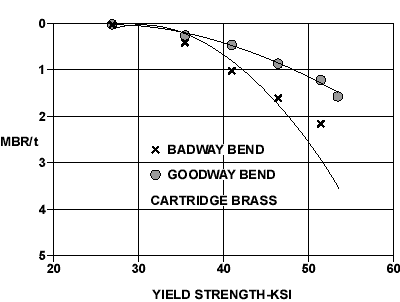The strip metals used for interconnection are often found to have "good way" and "bad way" bend directions with regard to formability. Cold-worked metals can often be formed with smaller bend radii when the axis of the bend radius is transverse to the original working direction, so this is considered the good way. This difference in formability is called directionality. The concept is illustrated in the figure, which shows how formability varies with strength and bend direction in cartridge brass cold-rolled to various tempers.
 Figure 4. Strength and Formability Trade-off.
Figure 4. Strength and Formability Trade-off.Because most cold-rolled strip alloys have better formability in the good way orientation, directionality can be an important factor in the selection process. When there is only one bend in a stamped part, or when all of the bends have their axis in the same direction, the designer can orient the part to avoid bad way bends. Unfortunately, part configurations frequently require both good and bad way bends. This usually has a marked affect on the strength of the metal that can be used for the particular design.
The width of the strip metal used to make the component part can also affect formability, an effect which is becoming more important with the trend toward smaller parts. Narrower strip can make sharper bends, but the effect is significant only when the strip becomes quite narrow. When the width to thickness ratio goes below about 8, more localized necking occurs and thus sharper bends are possible. Clean cut edges will help because fractures are now likely to initiate at the edges.
Generally, alloys in the annealed condition, or those strengthened by a small amount of cold work, can be formed without regard to forming direction. If, in spite of careful design, higher strength is required with good formability in all directions, the designer should consider the dispersion- or precipitation-strengthened alloys where the required strength can be achieved with little or no cold rolling. When final alloy choices are being made, it is best to obtain specific formability data from potential vendors.
